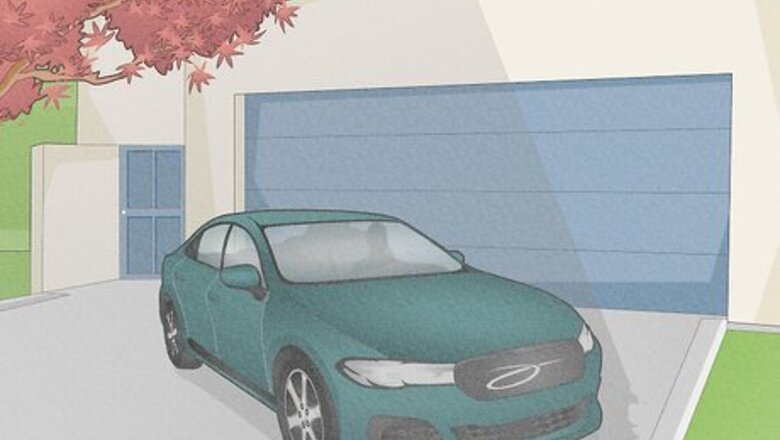
views
- Park your car in a shady spot. Gather your supplies and fill up 3 buckets: 2 with soapy water and 1 with clean water.
- Clean the wheels first with a stiff brush. Use a different bucket for your wheels than the rest of your car.
- Use a car wash mitt or a sponge to soap up the rest of your car. Rinse your car thoroughly with water once you’re done washing.
- Dry your car with a microfiber towel, and use wax for a shiny finish.
Gathering Supplies

Park your car in a shady spot. When the sun beats down on your car, it speeds up drying, which can leave splotches and soap scum on your paint. Try to find a shady location without direct sunlight to work as efficiently as possible. If you can, try washing your car on a surface that can absorb water, like gravel or grass. Washing your car on concrete or asphalt forces your soapy water to run into storm drains, which can degrade your local water quality.
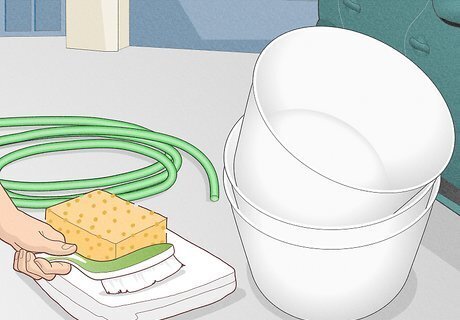
Place all of your supplies near your car. This includes the car wash soap that you will use for cleaning, a hose, 3 buckets (2 for washing, 1 for rinsing), sponges or mitts, and microfiber towels to dry your car. Get a stiff brush to scrub your tires and rims, and keep it separate from the rest of your supplies. Be prepared to get wet and soapy! Throw on some rubber sandals to protect your feet while you work without getting waterlogged.
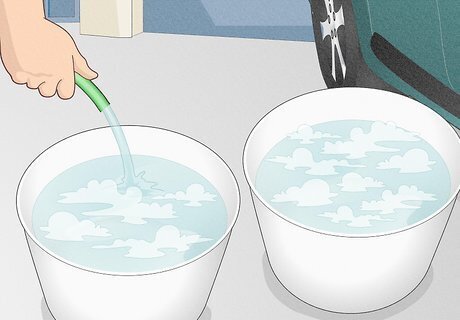
Fill 2 buckets with soapy water. The first 2 buckets will be your washing buckets: 1 for the body of your car, and 1 for the wheels. Grab your car wash soap and read the dilution instructions on the bottle, then fill a bucket with hose water and add in the soap. Most car wash soaps will instruct you to mix 20 parts water with 1 part soap. However, different soaps may have different directions, so check your bottle before pouring. Some sites may tell you that using dish soap on your car is okay. However, dish soap can degrade your car’s finish or strip the wax off. When in doubt, it’s best to use dedicated car wash soap. Learn proper car washing techniques as a beginner. "As a new car owner, I was nervous about screwing up washing my car. This article taught me the right steps, like starting on the roof, using separate buckets for wheels vs. the body, and rinsing often to avoid scratches. Now I feel totally comfortable washing my car properly at home without damaging the paint." - Jennifer M. Get specific tips to avoid common mistakes. "I used to just spray my car with the hose and scrub away. Reading this showed me better techniques, like checking my soap bottle for dilution ratios and not letting soap dry on the car. The reminders to clean the door jams and dry the car fully will help me avoid issues I've had before, too." - William M. Equip yourself with the right supplies. "I wanted to start washing my car myself but wasn't sure what I needed. The comprehensive list of supplies here, like car wash mitt, microfiber towels, dedicated wheel brush, and quality soap, let me equip my garage so I can get professional-looking results. Now, I'm excited to wash instead of dreading a chore." - Kevin L. Gain the confidence you can hand wash properly. "As a visual learner, I appreciated seeing the steps in images. It made techniques like starting at the top and using separate wash buckets obvious. Seeing exactly how much soap to use and how to scrub wheels gave me confidence that I could now hand wash my car the right way without messing up." - Diane M. We want to hear from you! Advice from our readers makes our articles better. If you have a story you’d like to share, tell us here.
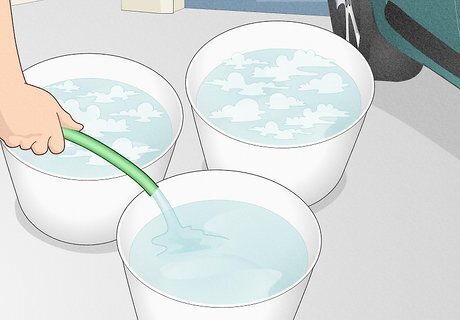
Fill a third bucket with clean water. This bucket is for rinsing your cleaning tools before dipping them back into soapy water. Grab a third, clean bucket, then use a hose to fill it up. It’s important to rinse off your tools often during the car washing process. If any rocks or pieces of debris get stuck in your rags or mitts, you could accidentally scratch your car.
Washing and Rinsing
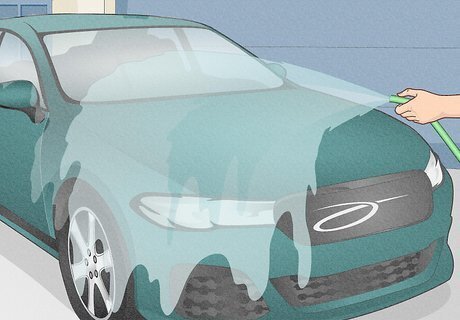
Hose off the car to loosen and soften the dirt. Start from the top of the car and work your way downward, spraying every nook and cranny. Don’t use a strong jet of water, since this could scratch your car. Aim the water downwards so any dirt and grime runs off your vehicle. EXPERT TIP Tom Eisenberg Tom Eisenberg Auto Technician Tom Eisenberg is the Owner and General Manager of West Coast Tires & Service in Los Angeles, California, a family-owned AAA-approved and certified auto shop. Tom has over 10 years of experience in the auto industry. Modern Tire Dealer Magazine voted his shop one of the Best 10 Operations in the Country. Tom Eisenberg Tom Eisenberg Auto Technician Washing your car more often will make your details last longer. Washing your car takes off 70 percent of the dirt, but if you only wash your car once every six months, it's going to have a lot of buildup and a simple wash isn't going to do anything.

Wash your wheels with a stiff brush. Since your wheels are probably the dirtiest part of your car, it’s a good idea to tackle those first. Dip your stiff brush into 1 bucket of soapy water, then use the brush to clean the rims and tires. Once you’ve scrubbed up your wheels, rinse them off with the hose. Remember, separate your bucket of soapy water that you use for the wheels, and don’t reuse it on the body of your car. Your wheels likely have small rocks or dirt chunks in them, and using the same soapy water on the body of your car could scratch your paint.
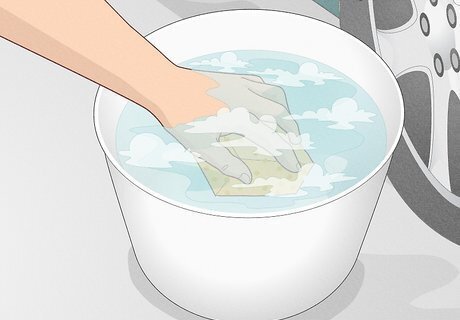
Dip a car wash mitt or sponge into the soapy water. Now it’s time to focus on the rest of your car. Grab your car wash mitt or sponge and put it into the bucket of soapy water that you haven’t touched yet. Get it nice and sudsy to clean your car quickly and effectively. As you wash your car, dip your mitt or sponge back into the soapy water every couple of minutes. Mitts, unlike sponges, can also be washed in washing machines to remove all the grit. However, you can choose whichever works best for you.
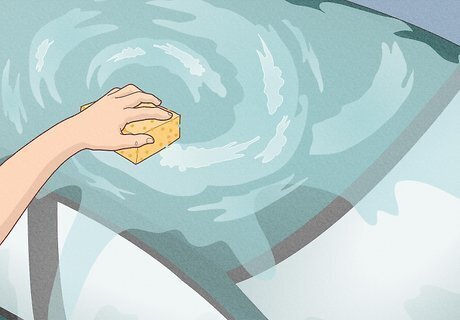
Wash the car section by section, starting at the top. Working from the top down lets the soapy water drip over the lower sections while you wash the higher sections. Start on the roof of your car, rubbing your mitt or sponge in circular motions. Circle around your car several times, washing lower areas each round. As you reach the lower parts of the car, be sure to focus on the crevices underneath the doors and the wheel wells. These parts of your car are usually pretty dirty, and they tend to trap dirt and grime.
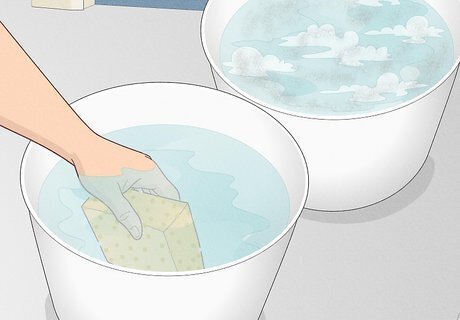
Rinse off your mitt or sponge regularly. Remember that clean bucket of water you filled up earlier? That’s for rinsing your scrubbing tool. After 1 pass over your car or after you scrub a particularly dirty spot, dip your mitt or sponge into the clean water to remove large objects. If your clean bucket of water ever looks opaque or gritty, dump it out and fill it with fresh water.
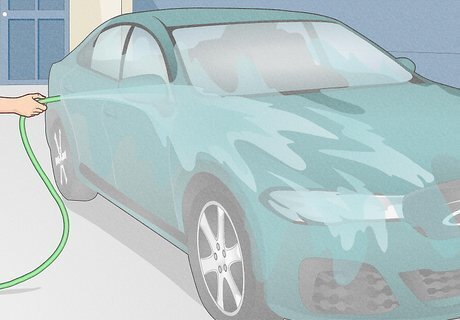
Rinse your car off as soon as possible. Soap dries quickly, and letting soap dry can leave a film that’s tough to get off. Once your car is nice and sudsy, grab your hose and start rinsing from the top down. Work your way down to the lower parts of your car, and don’t forget about the wheel wells, too! After you rinse, check your car again for any missed spots or bird droppings. If you need to, use your mitt or sponge to go over the area again, then rinse it off when you’re done.
Drying and Waxing
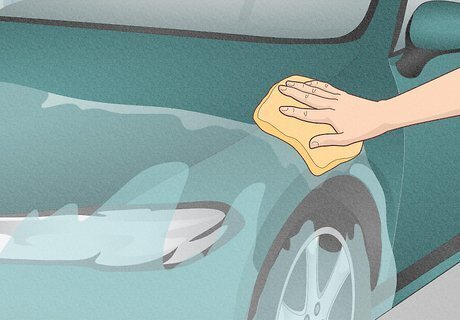
Dry your car with microfiber towels. Microfiber towels are gentle on your car, so they won’t scratch the paint. Use a few towels and work from the top down, slowly pushing the water off your car. Leaving standing water on your vehicle can leave spots, so do your best to wipe it all off. Use a fresh towel to dry off the windshield and the windows. When you’re finished drying your car, simply toss the towels in the washing machine and wash them like normal.
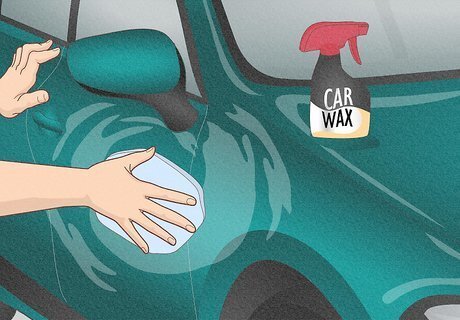
Wax your car for a shiny finish. Waxing your car isn’t 100% necessary, but it can help repel water and mild dirt and grime. Spray wax onto a microfiber towel, then gently wipe the product onto the body and windows of your car. Make sure your car is completely dry before applying wax.
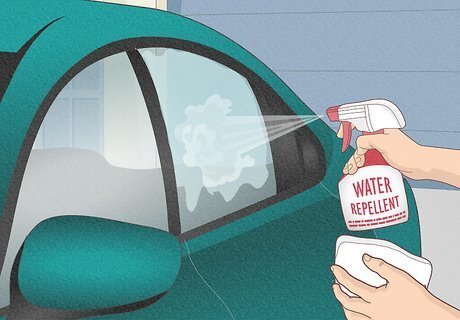
Apply a water-repellent treatment to the windows. Want to go the extra mile? A water-repellent will help rain water bead up and roll right off your windows. Spray a water-repellent treatment onto the windows of your car, then buff it in with a microfiber cloth. This step is also totally optional, so feel free to skip it if you’re happy with your car as-is.














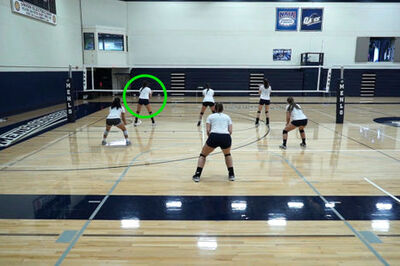



Comments
0 comment